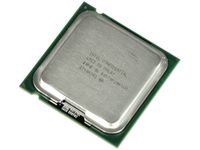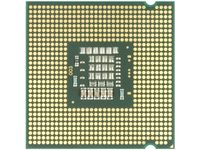Dual-Core Versus Quad-Core: Part 2
Intel Core 2 Duo E8500 (3.16 GHz Dual Core)
Intel’s Core 2 Duo has been available for two years now. When it first made its debut in 2006, it kicked the Athlon 64 X2 from the top, and it hasn’t given up the top position since that day. The introduction of the first Core 2 Quad resembled a product that combined two dual core dies, connected via the Front Side Bus.
The latest Core 2 Duo family, called the E7000 and E8000, is based on the 45 nm process, and delivers even better performance at reduced power consumption—it represents the most efficient processor choice available today. The Core 2 Quad Q9000 series is again based on two of these chips, but it doesn’t provide the same power efficiency as the dual cores. This is because of higher idle and maximum power, which doesn’t translate into equivalent performance gains due to applications not being optimized for more cores, or not being able to capitalize on the extra processing power. The Phenom X4, which we used for this article, suffers from the same issues.
Core 2 Duo Models
The best Core 2 Duo model currently is the E8400, which offers the best price performance ratio, but Intel has a total of eight 45 nm processors ranging from 3.33 GHz, FSB1333 bus speed and 6 MB L2 cache (Core 2 Duo E8600) to 2.53 GHz with 3 MB L2 cache and FSB1066 speed (E7200). Since the cost difference is small compared to the 65 nm generation (E4000 and E6000 series), we recommend going for a 45 nm model in any case, as these deliver better performance with lower power requirements.
Wolfdale Offers Best Performance per Clock
When you go back to the second page, where I listed related articles and article recommendations, you will find multiple analysis pieces that show the leading efficiency of the current Core 2 Duo generation. After years of following the wrong direction with the Pentium 4 and the Pentium D—where clock speed was all that mattered—Intel corrected its mistakes and found itself back on top. We used the lead model Core 2 Duo E8500, which is based on the Wolfdale core with its massive 6 MB L2 cache. Since these processors are capable of providing the best level of performance per clock, Intel has a double advantage over the Phenom X4 9350e: it offers 58% faster clock speed and more performance per clock. As you will see in the benchmark section, this is sufficient to let Intel win most of the benchmarks, despite the higher theoretical computing power of the four-core AMD processor.
Better Efficiency than AMD
Get Tom's Hardware's best news and in-depth reviews, straight to your inbox.
We already made clear on the AMD Phenom evaluation page that the efficiency difference between the dual core Core 2 and the quad core Phenom X4 should not be looked at as a general advantage for Intel, nor a general disadvantage for AMD. Fewer processing units will result in less total power consumption, just like more units can provide better overall performance at decreased efficiency. Intel is in the lucky position of having multiple advantages: faster architecture, a more advanced manufacturing process and faster clock speeds (both for dual and quad cores). Let’s look at the results.
Current page: Intel Core 2 Duo E8500 (3.16 GHz Dual Core)
Prev Page AMD Phenom X4 9350e (2.0 GHz Quad Core) Next Page Test Setup

